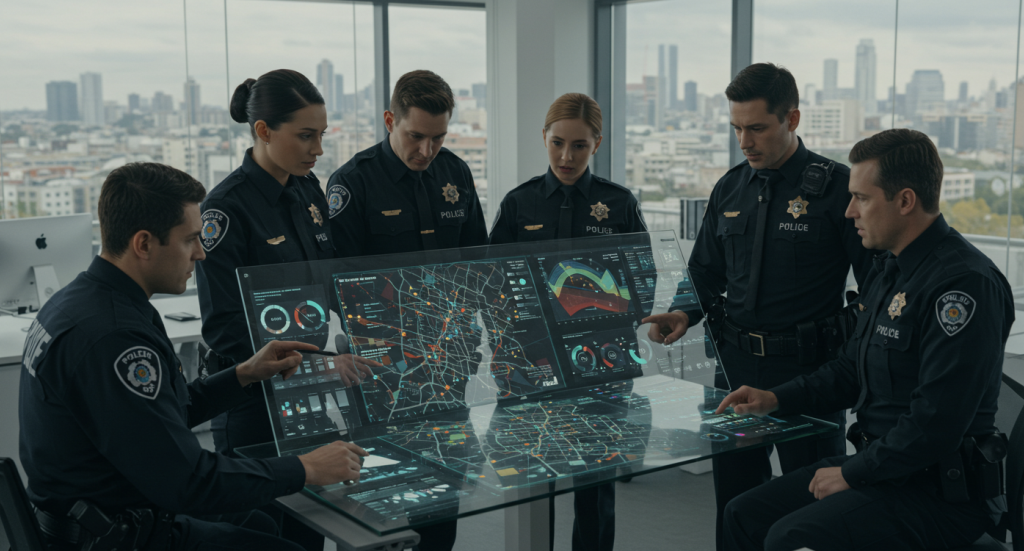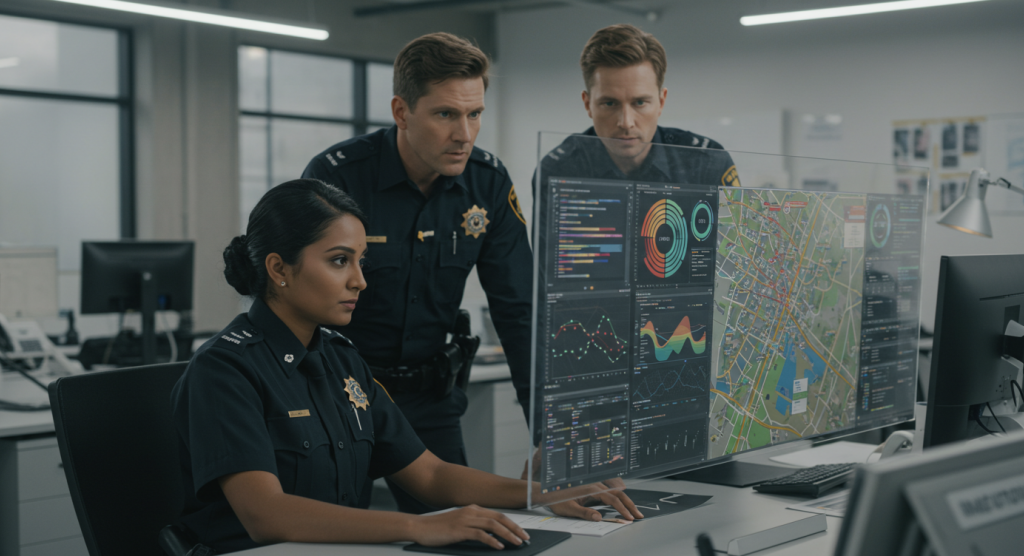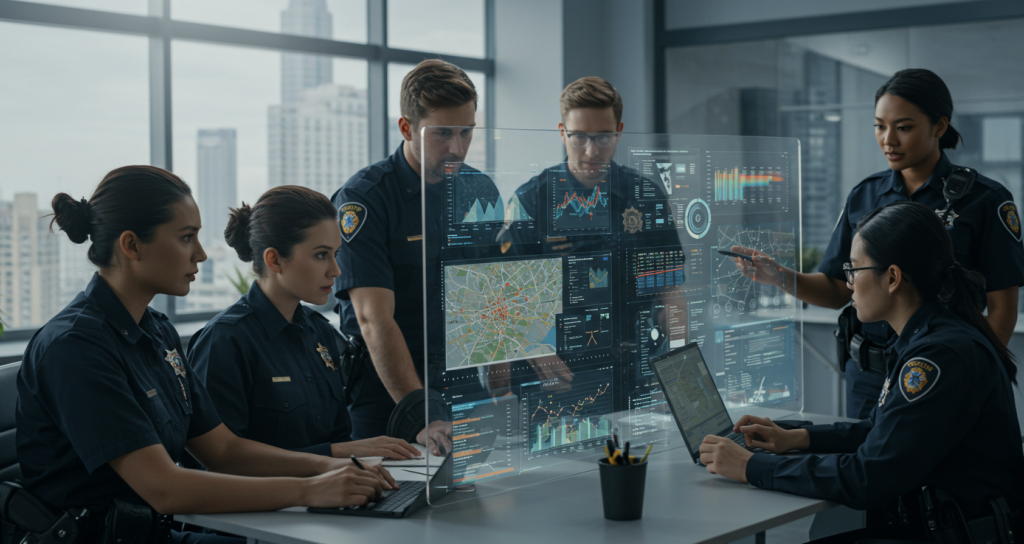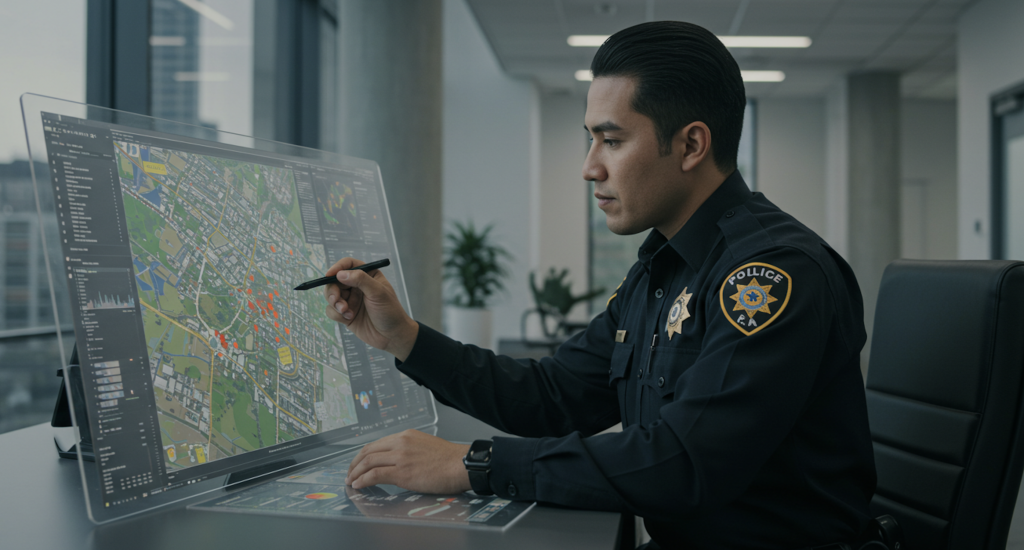
Quick executive summary
Policing in the U.S. today is a complex, contradictory job: officers face real physical risks (gunfire, vehicle crashes), high rates of trauma and mental-health strain, intense public scrutiny, and changing institutional tools (body cameras, military-grade equipment). Many of these pressures amplify the feeling “I could die or be seriously hurt right now,” while other changes (e.g., transparency tools, training reforms) push toward de-escalation. Comparing today to the 1960s shows big changes in technology, oversight, professionalization — but also continuity in the core stressors of street-level unpredictability and politicized public encounters. Below I synthesize research, national data, historical context and concrete ways GoVia’s model could be effective. Sources are cited for the most load-bearing claims.
1) What it’s like to be a police officer today (lived experience, nationally)
Short version: officers must hold two realities at once — constant readiness for lethal threat, and near-constant social/administrative scrutiny.
What officers face on the street
- Routine unpredictability: calls can shift from paperwork to life-threatening violence in seconds; officers train for rapid threat assessment but real situations are noisy, chaotic, and ambiguous.
- Physical risk: officers continue to be killed or seriously injured in the line of duty (gunfire, vehicle crashes, etc.), even as pandemic-related fatalities declined in recent years. National fatality counts fluctuate (136 officer line-of-duty deaths in 2023 is the most recent compiled figure).
- Mental-health burden: police have higher-than-background prevalence of PTSD, depression, and cumulative trauma exposure — multiple studies estimate police personnel have roughly twice the prevalence of PTSD/depression compared with the general population. This results from repeated exposure to violence, critical incidents, and moral/ethical stressors.
- Suicide risk: beyond line-of-duty deaths, suicides among law-enforcement personnel are significant — studies and reporting place average annual officer suicides in the high hundreds nationally (preliminary reporting counted ~183 suicides in 2022 across public safety personnel datasets).

What adds to stress beyond physical danger
- Public scrutiny and legal risk: body cameras, social media, civilian recordings, and the threat of civil/criminal review increase perceived legal exposure and reputational risk for routine decisions.
- Policy and political waves: high-profile incidents, national debates about use of force, and reform proposals mean officers operate amid politicized public expectations that can change dramatically in months. Public trust has shifted over recent years, with large demographic gaps in confidence.
- Institutional pressures: understaffing, long shifts, overtime, and administrative burdens (reports, court time) reduce recovery time and increase burnout. Training time priorities also vary, with some analyses finding firearms training hours have increased more than community-policing training in recent decades.
How “fear for your life” feels for an officer
- Acute physiological cascade: rapid heart rate, tunnel vision, time dilation, hyperfocus on threat cues — these are normal fight/flight reactions trained but still visceral.
- Split-second moral calculus: officers must weigh threat, bystander safety, proportionality and legal prudence in seconds; uncertainty about suspect intent or hidden weapons elevates existential fear.
- Long-term anticipatory stress: even off-duty, prior exposures create hypervigilance and intrusive memories that make future encounters feel more threatening.
2) Contrasting today with the 1960s
Big-picture differences
- Technology & transparency: today’s officers carry radios, tasers, ballistic vests, often body-worn cameras and weaponized responses can include military-grade equipment supplied through federal programs. In the 1960s, many patrols lacked modern ballistic protection, radios and standardized equipment; oversight was far less technologically mediated. (See sources on 1033/militarization and body-worn camera adoption.)
- Professionalization & training: policing became more “professionalized” after the 1960s with expanded academy curricula, centralized standards in many departments, and federal attention to training content. However, analyses show emphasis shifted over time (e.g., firearms hours increased more than community policing hours in some periods).
- Political context: the 1960s were a period of civil-rights unrest and frequent violent clashes between protestors and police; policing tactics were often overtly coercive and less responsive to civilian oversight. Today’s environment contains both the legacy of those confrontations and new arenas of conflict (social media, highly publicized inquiries, national reform movements).
Continuities
- Unpredictability and mortal risk: officers in the 1960s still faced ambushes, riots and lethal force risk. The emotional experience of “you might die on this shift” remains a throughline.
- Political visibility: then and now, policing is a public institution whose actions and legitimacy are contested in the courts, streets and media.
Net effect for officers’ lived experience
- In the 1960s officers had less technological protection but also less continuous public documentation and less immediate national scrutiny. Today officers may be better equipped and trained in some respects, but operate in a hotter media and legal environment, with different sources of stress (surveillance, burnout, mental-health fallout).
3) Evidence snapshot — key national data (most load-bearing points)
- Line-of-duty fatalities: 136 officer deaths in 2023 (preliminary NLEOMF report).
- PTSD / mental health: police personnel have roughly twice the prevalence of PTSD and depression compared to the general population in multiple systematic reviews.
- Officer suicides: reporting and studies show hundreds of suicides among public safety personnel annually (a reported ~183 suicides in 2022 in compiled datasets).
- Militarization correlation: empirical studies find a positive relationship between acquisition of surplus military equipment and the incidence of fatal force in some jurisdictions; critics argue the 1033 program contributed to harder policing tactics.
- Transparency tools: body-worn cameras are widely adopted (large departments much more likely to deploy them; adoption and deployment rates rose substantially across the 2010s), with mixed but promising evidence on accountability and behavior change when paired with policy reforms.

4) How “fear for your life” is experienced by civilians and overlaps with officer fear
- For officers, fear often emerges from ambiguity about suspect intent, hidden weapons, and dynamic environments. For civilians (especially Black, Brown, and other marginalized people), fear stems from historical patterns of policing, disproportionate use of force, and lived experiences of being treated as threats. These fears meet in encounters where both parties believe the other might be lethal — creating the worst-case, often-fatal dynamic. Research on trust and racial disparities shows large demographic gaps in confidence and perceived legitimacy, which amplifies mutual fear.
5) How GoVia (Highlight: Hero) could be effective — practical, research-grounded deployment ideas
Below are concrete interventions GoVia can operationalize, why they’re evidence-based, and how to measure success.
- Pre-encounter transparency + video chat for de-escalation
- What: offer immediate, optional video connection between citizen and responding officer (or 911 dispatcher) so an officer can see context and a civilian can show hands/room layout — reducing ambiguity.
- Why: ambiguity about intent and hidden threats fuels fear. Visual context can reduce misperception and allow remote de-escalation steps. Evidence on crisis-intervention and dispatch enhancements shows better information reduces risky tactical errors. (While randomized trials are scarce, transparency concepts align with research showing bodycams and clearer audio/video context affect behavior.)
- Metrics: reduction in use-of-force incidents for participating calls (compare baseline), time-to-resolution, participant satisfaction scores.
- Real-time access to advocates/attorneys and mental-health professionals
- What: an in-app “call my lawyer” and “call a clinician” option that documents the offered connection and — when accepted — records the professional’s presence on the call.
- Why: the presence of neutral, trained observers can moderate escalation, provide legal clarity and offer immediate mental-health triage; legal counsel reduces panic and clarifies rights. Studies of third-party observers and procedural fairness link perceived legitimacy and calmer outcomes.
- Metrics: number of calls where counsel/clinician joined, downstream complaints, litigation rates, user and officer post-encounter calmness surveys.
- Structured evidence capture for both parties (secure, tamper-evident)
- What: synchronized multi-party recording (citizen, officer camera), cryptographically sealed, with chain-of-custody logging to remove disputes about tampering.
- Why: disputes about who recorded what and when drive public mistrust. When evidence is reliable, investigations conclude faster and community trust increases. NIJ research supports the role of bodycams when accompanied by policy.
- Metrics: investigation duration, resolution rates, FOIA requests, policy compliance.
- Officer mental-health module and post-incident support
- What: confidential workflows that automatically offer peer support, clinician contact, and short-term counseling after critical incidents; anonymized analytics to identify high-risk patterns for early intervention.
- Why: high PTSD and suicide rates among officers call for proactive care. Early intervention reduces chronic PTSD and improves retention.
- Metrics: uptake of support services, reductions in sick days, self-reported wellbeing scores, suicide risk indicators.
- Data sharing and community scorecards (with privacy protections)
- What: anonymized dashboards showing aggregated encounter metrics (calls handled, percent with third-party observers, de-escalation success, complaint counts) — accessible to community boards and department leadership.
- Why: transparency with aggregated, privacy-safe data rebuilds legitimacy and helps target training and accountability. Pew and other organizations show trust improves where data and meaningful oversight exist.
- Metrics: community trust surveys, complaint trends, changes in use-of-force rates.

Operational design notes (to maximize effectiveness)
- Opt-in with strong privacy controls: allow citizens and officers to opt into different levels of recording while maintaining legal rigor; cryptographic seals to protect data integrity.
- Policy anchoring: partner with departments to align GoVia workflows with use-of-force, evidence, and retention policies so data is admissible and reduces friction.
- Training & simulation: offer scenario-based training overlays (virtual walkthroughs) that use anonymized call data to show best practices — research shows scenario training improves split-second decision-making.
- Independent governance board: include community members, civil-rights lawyers, mental-health experts and law-enforcement reps to oversee metrics and transparency reports.
6) Concrete, measurable pilot plan (a compact roadmap)
- Phase 1 (60–90 days): Deploy in one precinct or school district; enable video triage + third-party observer on non-emergent calls. Track baseline metrics for 3 months.
- Phase 2 (3–9 months): Add attorney/clinician connector; integrate automated after-incident support for officers. Begin quarterly public dashboards.
- Phase 3 (9–18 months): Expand, run a quasi-experimental evaluation comparing matched precincts (GoVia vs control) on use-of-force, complaints, time-to-resolution, and officer mental-health indicators.
Key success metrics (examples)
- % reduction in use-of-force incidents for enrolled calls.
- % reduction in complaints and time to complaint resolution.
- Officer wellbeing uptake and self-reported PTSD symptom reductions over time.
- Community trust index (pre/post deployment surveys).
7) Final reflections — balance, legitimacy, and human work
Policing will always be a human profession with unavoidable split-second danger. What changes is the environment around those split seconds: clearer information, better mental-health support, transparent evidence, and community participation can reduce mutual fear. The 1960s remind us that tactics and tools change, but without legitimacy and accountability, mistrust grows. GoVia’s model—if it centers real time transparency, legal and clinical supports, and rigorous privacy/chain-of-custody controls—can reduce ambiguity (the main driver of lethal fear), improve outcomes for officers and civilians, and create data that departments and communities can use to reform operations.
If you’d like, I can now:
- Turn this into a 900–1,200 word blog post in the GoVia tone (inviting + hard-edged research).
- Draft a 1-page pilot plan with KPIs and a one-paragraph funder pitch. Tell me which and I’ll produce it immediately.





